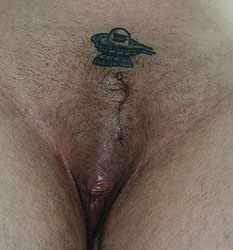Penectomy
Penectomy is the complete (or sometimes partial) removal of the penis. The scrotum and testicles are almost always removed first—this results in the appearance of a genderless state, although many remain sexually active. In most cases, the base of the penis is left on to some extent.
Usually fantasy, as in castration, but at other times gender confusion or hatred, or even psychosis can result in penectomy. A eunuch I interviewed adds:
- "Removal of the penis is desired by some gay males, usually those already made eunuchs. Some eunuchs later desire penis removal only after having been eunuchs for several years. Removal of the penis is involved and requires significantly greater skill than removal of the testes. Use of elastrator bands is recommended to prevent loss of blood. Advanced techniques of nullification include severing the suspensory ligaments to drop the penis before amputating it, to produce a urinary outlet lower down for convenience. A new urinary opening may be made between the root of the penis and the anus, but this involves advanced incision and suturing skills. Such an opening reduces the need to remove more of the penis itself to lower the urinary opening for convenience. Preservation of the penis in formalin results in a leathery gray rod and retention of the thickness and volume of the original organ is usually not satisfactory as a display keepsake. Few accounts exist on the eating of the amputated penis and no reliable data exists as to its texture or taste."
While some individuals have managed to perform their own penectomies using a combination of elastrator and catheter, the majority opt to have an underground professional or doctor do the procedure. Infection and massive blood loss are the major risks. However, the area heals surprisingly well and quickly. In many cases even home butcher-knife operations can (and typically do) heal on their own without major medical intervention (although this is not recommended at all).
